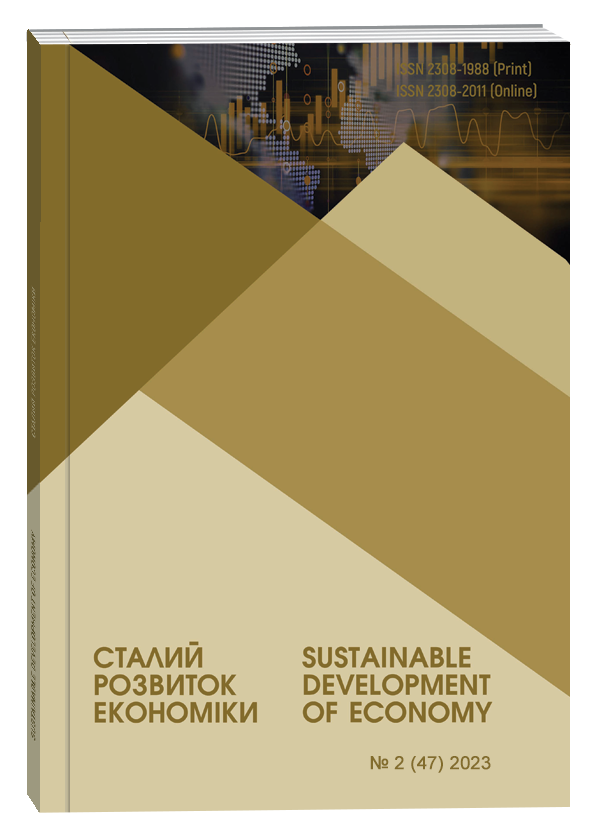ANALYTICAL JUSTIFICATION FOR THE PROJECT OF BUSINESS ENTITY’S CORPORATE ARCHITECTURE DEVELOPMENT
Abstract
The development of corporate architecture is a fundamental prerequisite for successful strategic planning, efficiency enhancement, change management, and fostering innovation in modern enterprises. The need to expand the adaptive capabilities of economic entities and incorporate cutting-edge tools into business practices can only be addressed through the formation of practical corporate architecture development projects, which necessitates proper analytical justification. This article aims to develop theoretical and methodological foundations for building the corporate architecture of a business entity based on a reasonable analytical explanation of the parameters of the respective development project. The author's hypothesis posits the alignment of changes in corporate architecture with the quantitative, qualitative, and structural changes accompanying the development processes of the business entity. It's argued that the analytical support for the development projects of a business entity should be unfolded through architectural modeling using Archimate meta-models and the concept of corporate architecture maturity. The following models are anticipated within the Archimate model: financial, technological, security, risk, environmental, customer experience, culture, and innovation. Maturity refers to stakeholders' awareness of corporate architecture's content, structure, and impact on the realization of business logic. The delineation of three levels of corporate architecture maturity is justified: initial, developed and optimized. The maturity level assessment is proposed to be carried out using expert evaluation based on the Rasch scale. For this purpose, a list of statements characterizing the level of maturity has been developed for each architectural model and each level of maturity, anticipating a binary response. It is also proposed to assess the level of maturity through the consistency and mutual support of architectural models. An example is provided for formulating Rasch scale statements to assess such alignment. To compare the two directions of evaluation, the application of the strategic matrix "maturity – alignment" is proposed, which can be detailed into a set of matrices "maturity of a component of corporate architecture – alignment with other components of corporate architecture".
References
Corsi P., Neau E. (2015) Innovation Capability Maturity Model. USA: Wiley.
Bata T., Lyndon P., Schlamann H., Ulrich W. (2020) The Business Architecture Metamodel Guide. USA: Business Architecture Guild.
Camargo F.R., Henson B. (2015) Beyond usability: designing for consumers’ product experience using the Rasch model. Journal of Engineering Design, no. 26:4-6, pp. 121–139.
CMMI (Capability Maturity Model Integration) for Development. URL: https://resources.sei.cmu.edu/library/asset-view.cfm?assetID=9661
Desfray P., Raymond G. (2014) Modeling Enterprise Architecture with TOGAF. Amsterdam: Elsevier Inc.
Dietz J., Mulder H. (2020) Enterprise Ontology. A Human-Centric Approach to Understanding the Essence of Organisation. Switzerland: Springer.
Engelhard G., Wang J. (2021) Rasch Models for Solving Measurement Problems. Los Angeles: SAGE.
Finkelstein C. (2006) Enterprise Architecture for Integration: Rapid Delivery Methods and Technologies. Boston: Artech House.
Gharajedaghi J. (2011) Systems thinking: managing chaos and complexity: a platform for designing business architecture. USA: Morgan Kaufmann.
Lankhorst M. (2017) Enterprise Architecture at Work. Modelling, Communication and Analysis. New York: Springer.
Sousa P., Vasconcelos A. (2022) Enterprise Architecture and Cartography: From Practice to Theory; From Representation to Design. Switzerland: Springer.
The TOGAF Standard. Version 9.2. (2018) U.S.: The Open Group.
Whelan J., Meaden G. (2012) Business architecture: a practical guide. New York: MPG Books Group.
Wierda G. (2021) Mastering ArchiMate. Instruction to the ArchiMate enterprise architecture modeling language. The Netherlands: R&A.


